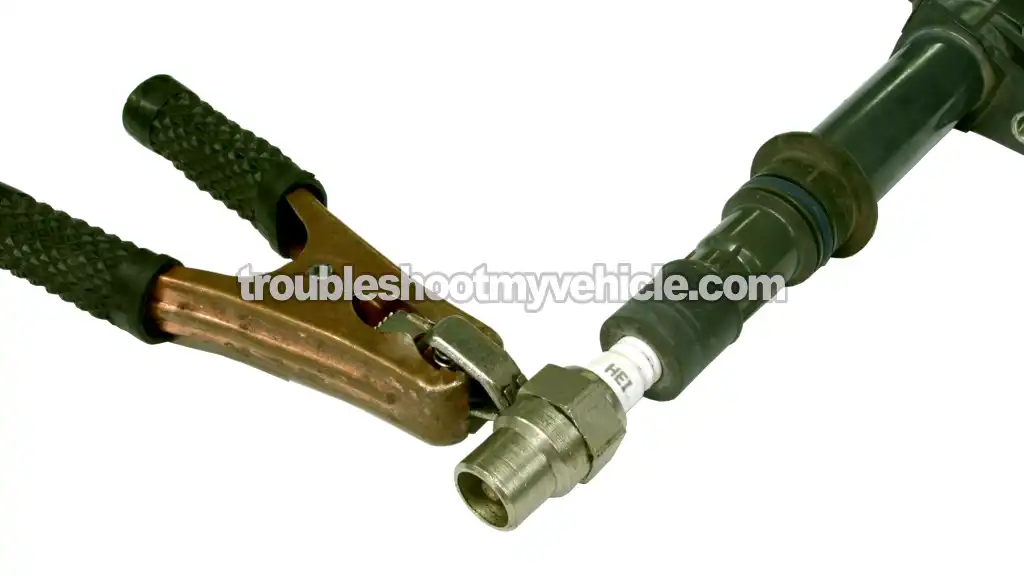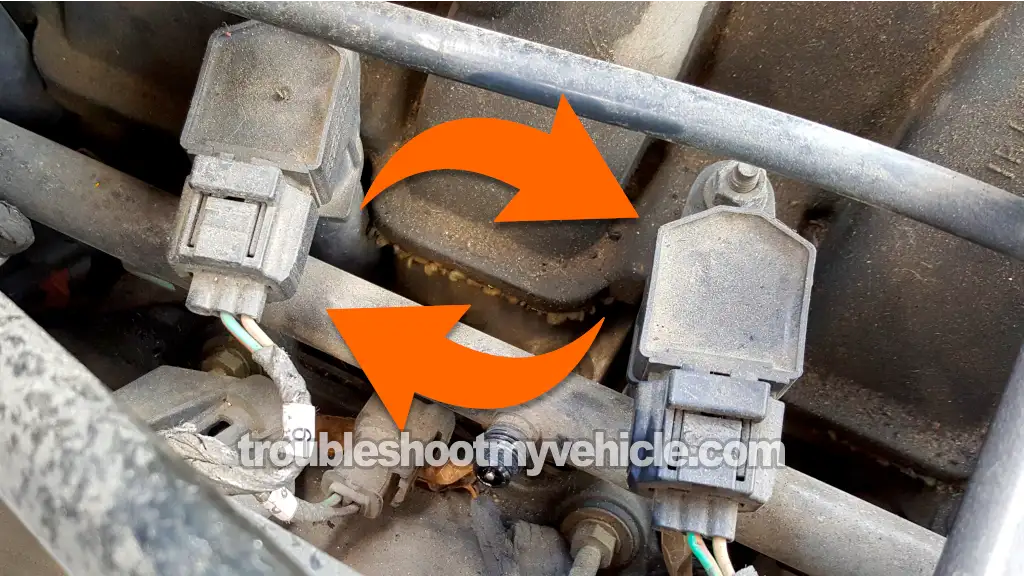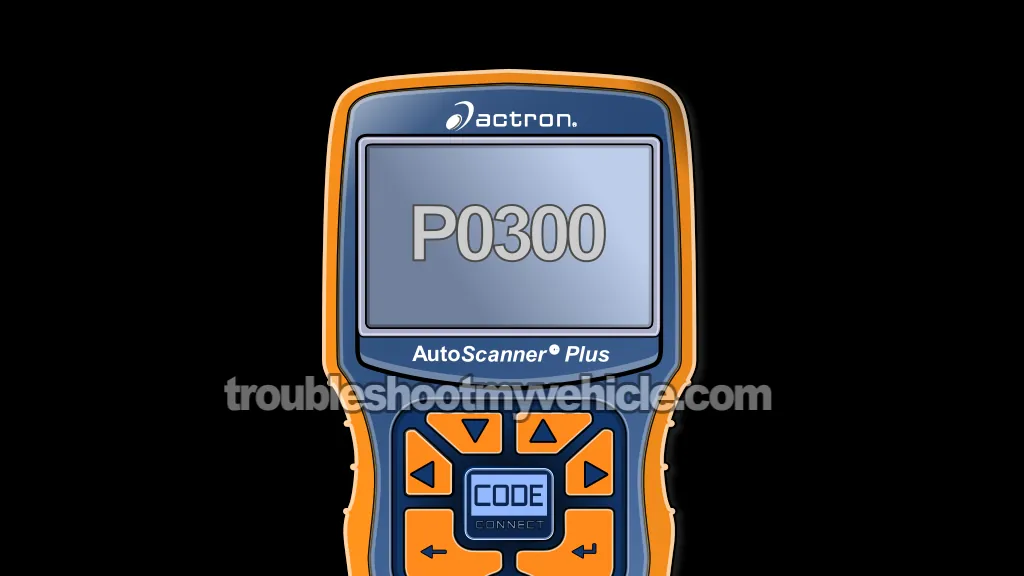TEST 2: Check The Ignition Coil For Spark

The very first thing you need to do, is check to see if the COP ignition coil is sparking or not.
My instructions below call for an HEI spark tester and if you don't have one, you may be wondering if you can use any other type of spark tester.
And the answer is yes you can use any type of spark tester you want or have. The main reason I use and recommend the HEI spark tester is because this bad boy is accurate (and you don't have to worry about interpreting the color of the spark).
OK, to get your COP ignition coil diagnostic going, this is what you need to do:
- 1
Remove the ignition coil from its place on the valve cover.
- 2
Connect an HEI spark tester to the ignition coil.
- 3
Ground the HEI spark tester with a battery jump start cable directly on the battery negative (-) terminal.
- 4
When everything is set up, have a helper crank the engine while you observe the spark tester.
- 5
The spark tester will do one of two things: Spark or not spark.
Let's take a look at your test results:
CASE 1: You got spark. This tells you that ignition coil is OK.
So, if you have a misfire code for the specific engine cylinder this COP coil belongs to then you need to look at the following things:
- Oil dripping onto the spark plug and COP coil boot from the valve cover gasket.
- Spark plugs for carbon tracks.
- Low engine compression in this cylinder.
CASE 2: You DID NOT get spark. Around 90% of the time, this test result tells you that the COP ignition coil is bad. To make sure, there's one more thing that you need to do.
And this is to make sure that the COP ignition coil (that did not spark) is getting both power and the switching signal. This can very easily be accomplished by simply swapping a good and sparking COP coil in place of the one that's not sparking and repeating this test. For this test, go to: TEST 3: Swap The ‘No Spark’ COP Coil.
TEST 3: Swap The ‘No Spark’ COP Coil

So far, you've confirmed that there's a COP coil that's not sparking (TEST 2) and as mentioned in TEST 2, this usually means that you have a bad COP coil on your hands but not always.
To make sure that the COP coil is truly fried, in this test step, you're gonna' swap ignition coils and test for spark again.
If the good COP ignition coil sparks (in the place of the one that did not spark) then you now know beyond a shadow of a doubt that the COP coil is getting all 3 signals from its connector.
This is what you'll need to do:
- 1
Unplug and remove the COP ignition coil that did not spark.
- 2
Choose one of the other COP coils that is sparking and remove it from its place.
Verify that the COP coil is sparking by testing it with your spark tester (if necessary). - 3
Connect the good COP coil to the connector of the bad COP ignition coil.
Next, connect the HEI spark tester to this good COP coil.
Ground the HEI spark tester with a jump start cable directly on the battery negative (-) terminal. - 4
Place the bad COP ignition coil in the location of the good one you just removed and bolt it down.
- 5
Once everything is ready, have your helper crank the engine.
- 6
The good ignition coil should spark.
Let's take a look at your test results:
CASE 1: The COP ignition coil sparked. This tells you that the COP coil that did not spark in TEST 2 is bad and needs to be replaced.
If you need/want to save a few bucks and buy a good quality COP coil for your vehicle, look at this section: Where To Buy The COP Ignition Coil And Save for my suggestion.
CASE 2: The COP ignition coil DID NOT spark. This tells you that the COP coil (you just swapped) is good and that the reason it's not sparking is a lack of power or a switching signal.
The next step for you is to:
- Check that one of the two wires is providing power (10 to 12 Volts).
- This is usually the light green with orange stripe wire.
- Check that the other wire is providing the PCM's switching signal.
What usually happens here is one of two things: either the switching signal wire has an ‘open-circuit’ problem between the coil connector and the PCM connector or the PCM goes bad.
Having a bad PCM is a rare thing to happen, but it does happen. Although it's beyond the scope of this article to test this condition, you now at least know what direction your diagnostic needs to take.
TEST 4: Cylinder Balance Test
A cylinder balance test will help you determine which engine cylinder is the one missing (misfiring), especially when the PCM does not set a specific misfire trouble code.
In a nutshell, the cylinder balance test involves starting the engine, letting it idle, and then unplugging one fuel injector at a time to see which cylinder is ‘dead’.
By ‘dead’ I mean not contributing to engine power. Now, let me go into more specifics: If an engine cylinder is getting both spark, fuel, and has good compression and you unplug its fuel injector connector, you're gonna' visibly see the engine shake more.
But if that engine cylinder is not getting one of the three (fuel, spark, or compression), unplugging the fuel injector WILL NOT cause a difference in idle at all (the engine will not shake more).
This type of cylinder balance test is very effective at finding the ‘dead’ cylinder. What I usually do, to further aid in finding the dead cylinder, is attaching a vacuum gauge to the intake manifold and as I unplug each fuel injector I listen/look for the change in idle and see if the vacuum gauge's needle also records the change.
OK, this is what you need to do:
- Start the engine and let it idle.
- Once the idle has stabilized, briefly unplug the fuel injector for cylinder #1.
- If the cylinder is ‘dead’
- You won't see/feel a difference in the engine's idle quality.
- If the cylinder is NOT ‘dead’
- You'll see/feel a difference in the engine's idle quality.
- Now reconnect the fuel injector and move on to the next fuel injector and disconnect and connect its connector and check for a drop in engine RPM's.
- Test all engine cylinders in this manner.
Let's take a look at your test results:
CASE 1: The cylinder balance test identified a ‘dead’ cylinder. Now that you have identified the cylinder with the misfire, the next step is to check and confirm that it's not being caused by a bad COP (Coil-On-Plug) ignition coil.
This involves checking the COP ignition coil for spark, you can now start with: TEST 2: Check The Ignition Coil For Spark.
CASE 2: The cylinder balance test DID NOT identify a ‘dead’ cylinder. This tells you that you don't have a specific ‘dead’ cylinder.
Now, if your vehicle is experiencing a rough idle condition then it's something that's affecting all of the cylinders and not just one. My suggestion in this case is to look at: Common Causes Of A P0300.
Common Causes Of A P0300

What really sucks (when diagnosing a misfire condition) is when the check engine light is being illuminated by a P0300 Random Cylinder Misfire trouble code.
This is because the PCM can not pinpoint a specific engine cylinder as the cause of the misfire and that whatever is causing the problem, is affecting the majority (or all) of the cylinders.
In this section, I'm gonna' offer you a few suggestions to get to the bottom of such a dilemma:
- Visually inspect spark plugs and COP coil boots.
- What you're looking for is extreme wear and tear on the spark plugs and COP coil boots.
- This also includes checking for:
- Cracks on the spark plugs porcelain insulator.
- Carbon closing the spark plug's center electrode gap due to the engine burning oil.
- Carbon tracks on the spark plug and COP coil boot.
- Oil leaking and soaking the spark plugs and/or COP coil boots.
- Water soaking the spark plugs and/or COP coil boots from power washing the engine.
- Check for leaking intake manifold gaskets.
- The intake manifold gaskets are made out of rubber and over time, this rubber gets compressed to the point that it looses its sealing ability.
- This can be done by spraying carb. Cleaner around the intake manifold while the engine is running.
- IMPORTANT: You should never spray carburetor cleaner on a hot engine, or you run the risk of a fire. This test should be done with an engine that has not reached normal operating temperature.
- Whenever the carb spray is sucked into the spot that's bad (on the intake gasket), the engine's RPMs will rev up.
- Fuel injector resistance test.
- There's a good chance that the miss (rough idle condition, misfire condition) is being caused by a bad fuel injector.
- Check fuel pressure.
- Low fuel pressure will cause the air/fuel mixture to go Lean and will cause a rough idle condition.
- Engine compression test.
- This is a pretty simple, yet overlooked test, in finding the cause of a rough idle condition.

If this info saved the day, buy me a beer!

